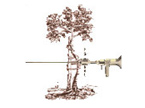1. What is shoulder arthritis?
Arthritis is a condition that occurs in various joints in the body, especially in the knees, hips, and spine. It can affect any joint, but the shoulder is affected infrequently. When arthritis occurs, the cartilage that covers the ends of the bones making up the joint breaks down and often flakes off into the joint. The joint becomes swollen and stiff, and the lining tissue of the joint (the synovium) becomes overgrown. Frequently, spurs will develop around the margins of the joint and can, sometimes, break off inside. The pain can vary from mild to very severe, depending upon many factors, including the severity of the disease, the type of arthritis (most are wear and tear, or degenerative arthritis, but some are caused by rheumatoid disease) and the activity level.
2. Who usually gets arthritis?
Anyone can develop arthritis, but it most often occurs in middle aged patients and senior citizens. The condition may occur spontaneously or as a late result of previous trauma, such as fracture or dislocation. It also may occur as a result of an inflammatory disease such as rheumatoid arthritis.
3. How do I know if I have arthritis?
The shoulder joint becomes stiff, feels heavy, and fatigues easily when arthritis is present. The stiffness is usually worse in the morning, and can slowly improve with “warm up activities.” Also, grinding and catching in the shoulder is a common sign of arthritis.
4. What tests can the doctor do to prove if arthritis is present?
Most advanced cases of arthritis can be diagnosed with an x-ray evaluation of the shoulder. Sometimes, with rheumatoid or other types of “inflammatory” arthritis, special blood tests or other evaluations are needed.
5. What is the best treatment for arthritis of the shoulder?
The treatment of shoulder arthritis depends on how disabling and painful the disease is. Often your doctor will refer you to a rheumatologist who specializes in treating arthritis with medications. Physical therapy, particularly hydrotherapy (swimming pool), is very soothing, and helps maintain or regain range of motion of the joint, and strengthen the surrounding muscles. If the arthritis is advanced, causing severe pain and disability, then your doctor may consider an operative procedure. Some early arthritis can be treated with arthroscopic (microsurgical) techniques. With this operation, the doctor will trim out the inflamed synovial lining tissue and remove debris and pieces of degenerated cartilage. Of course, this will not cure the arthritis, but frequently can relieve many of the symptoms, at least for a while. In severe disease, the only surgical treatment is joint replacement. This is a very good operation for pain relief and often will restore some motion, but it has its limitations. The joint surfaces are surgically replaced through a five inch incision in the front of the shoulder, and a metal ball and plastic socket are inserted.
6. If total shoulder joint replacement is needed, what are some of the risks?
The risks of total shoulder replacement are those of any standard surgical procedure and include infection, anesthesia risks (including death), nerve and vascular injury about the shoulder, and failure of the operation. If the operation fails, it may result in stiffness or sometimes a loose joint. If the joint becomes loose, it may either have to be redone at a future date, or reoperated to have the ligaments or muscles tightened. In the shoulder joint, this is quite a rare occurrence, although long-term follow-up of more than 10 years is not yet available.
7. What is the postoperative treatment after shoulder replacement?
If the shoulder was extremely tight, the doctor prefers to support the arm in a brace after surgery that allows the muscles and ligaments to heal in a lengthened position. If the shoulder was not particularly tight, then the arm can be kept in a sling at the side. Exercises begin on the day after surgery, and include movement of the elbow, wrist and hand, and exercising the grip with putty. Shortly thereafter, rotational pendulum exercises can be added. Strengthening exercises begin at about three weeks when the brace or sling is removed. This delay is necessary to allow the tissues that were opened at the time of surgery to heal.
8. How long will it take my shoulder to improve to its maximum?
The shoulder will generally continue to improve quite steadily up to five to six months after surgery. After that point, further improvement is very slow; although it has been shown that even after a year or more, activity can increase as muscle strength continues to improve. It is very important to continue an exercise program to regain and maintain excellent muscle strength around the new shoulder joint.
9. What is the postoperative treatment and rehabilitation?
Postoperatively, treatment depends on the type of surgery performed. Usually, when the Mumford procedure is performed using arthroscopic techniques, the arm can be treated with a sling. Bathing is allowed in three days’ time, and elbow, wrist, and hand exercises are begun immediately. Lifting is limited for three weeks, but following that, progressive exercise and motion activities proceed as the symptoms allow.
When a Weaver-Dunn procedure (rebuilding of the torn ligaments) is needed, approximately two or three weeks is added to the immobilization time before motion exercises are begun. This time allows the ligament to heal. Otherwise, the exercise program is the same as that for the Mumford procedure above.


